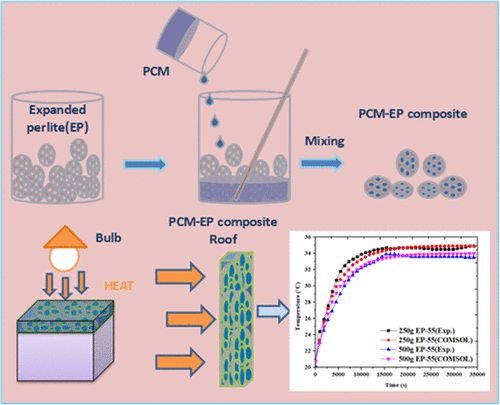当前位置:
X-MOL 学术
›
Energy Fuels
›
论文详情
Our official English website, www.x-mol.net, welcomes your feedback! (Note: you will need to create a separate account there.)
Thermal Buffering Performance of a Propyl Palmitate/Expanded Perlite-Based Form-Stable Composite: Experiment and Numerical Modeling in a Building Model
Energy & Fuels ( IF 5.3 ) Pub Date : 2021-01-20 , DOI: 10.1021/acs.energyfuels.0c03553 Prakhar Dixit 1 , Jagadeeswara Reddy Vennapusa 1 , Sumit Parvate 1 , Jitendra Singh 1 , Aravind Dasari 2 , Sujay Chattopadhyay 1
Energy & Fuels ( IF 5.3 ) Pub Date : 2021-01-20 , DOI: 10.1021/acs.energyfuels.0c03553 Prakhar Dixit 1 , Jagadeeswara Reddy Vennapusa 1 , Sumit Parvate 1 , Jitendra Singh 1 , Aravind Dasari 2 , Sujay Chattopadhyay 1
Affiliation

|
A phase change material (PCM) composite was prepared by impregnating propyl palmitate in expanded perlite (EP, as a support matrix), and its thermal buffering performance was tested in building applications. Five composites with varying PCM contents, i.e., 60, 55, 50, 45, and 40%, were prepared, and the composite with 55 wt % (EP-55) was chosen for thermal buffering performance analysis. All composite samples showed melting between 18.5 and 18.8 °C (as a PCM), while attenuated total reflection-infrared spectroscopy analysis confirmed simple physical adsorption occurring between the PCM and EP. Differential scanning calorimetry measurements (EP-55) showed a phase change enthalpy of 81.98 ± 1 J g–1, and stable performance during 1000 thermal cycles with the EP-55 composite confirmed appreciable thermal stability and reliability. The thermal buffering performance of the composite was tested in a building model, which was simulated using COMSOL Multiphysics 5.5. The unsteady-state energy (conduction/convection/radiation and latent heat of a PCM) transport from a source to the building was expressed mathematically along with its boundary conditions. The model was validated using a blank and with a composite, which was later applied to predict another unknown case. The model-predicted temperatures could very closely match (< ±4.0%) with experimental values.
中文翻译:

棕榈酸丙酯/膨胀珍珠岩基形状稳定复合材料的热缓冲性能:建筑模型中的实验和数值模拟
通过在膨胀珍珠岩(EP,作为支撑基质)中浸渍棕榈酸丙酯来制备相变材料(PCM)复合材料,并在建筑应用中测试了其热缓冲性能。制备了五种具有不同PCM含量(即60%,55%,50%,45%和40%)的复合材料,并选择了55 wt%的复合材料(EP-55)进行热缓冲性能分析。所有复合样品的熔点都在18.5至18.8°C之间(作为PCM),而衰减全反射红外光谱分析证实了PCM和EP之间发生了简单的物理吸附。差示扫描量热法测量(EP-55)显示相变焓为81.98±1 J g –1,以及使用EP-55复合材料在1000个热循环中的稳定性能,证实了可观的热稳定性和可靠性。在建筑模型中测试了复合材料的热缓冲性能,该模型使用COMSOL Multiphysics 5.5进行了模拟。从源到建筑物的非稳态能量(PCM的传导/对流/辐射和潜热)及其边界条件用数学方法表示。该模型使用空白和复合材料进行了验证,随后用于预测另一个未知病例。模型预测的温度可能与实验值非常接近(<±4.0%)。
更新日期:2021-02-04
中文翻译:

棕榈酸丙酯/膨胀珍珠岩基形状稳定复合材料的热缓冲性能:建筑模型中的实验和数值模拟
通过在膨胀珍珠岩(EP,作为支撑基质)中浸渍棕榈酸丙酯来制备相变材料(PCM)复合材料,并在建筑应用中测试了其热缓冲性能。制备了五种具有不同PCM含量(即60%,55%,50%,45%和40%)的复合材料,并选择了55 wt%的复合材料(EP-55)进行热缓冲性能分析。所有复合样品的熔点都在18.5至18.8°C之间(作为PCM),而衰减全反射红外光谱分析证实了PCM和EP之间发生了简单的物理吸附。差示扫描量热法测量(EP-55)显示相变焓为81.98±1 J g –1,以及使用EP-55复合材料在1000个热循环中的稳定性能,证实了可观的热稳定性和可靠性。在建筑模型中测试了复合材料的热缓冲性能,该模型使用COMSOL Multiphysics 5.5进行了模拟。从源到建筑物的非稳态能量(PCM的传导/对流/辐射和潜热)及其边界条件用数学方法表示。该模型使用空白和复合材料进行了验证,随后用于预测另一个未知病例。模型预测的温度可能与实验值非常接近(<±4.0%)。


























 京公网安备 11010802027423号
京公网安备 11010802027423号